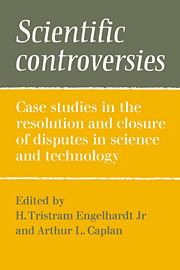 Scientific Controversies
Scientific Controversies Book contents
- Frontmatter
- Contents
- Preface
- List of contributors
- Introduction: Patterns of controversy and closure: the interplay of knowledge, values, and political forces
- PART I THEORETICAL PERSPECTIVES
- PART II CONTEMPORARY CASE STUDIES
- 12 Resolution of the Laetrile controversy: past attempts and future prospects
- 13 Federal regulation of Laetrile
- 14 Quasi libertarianism and the Laetrile controversy
- 15 Judicial deflection of scientific questions: pushing the Laetrile controversy toward medical closure
- 16 Politics, science, and the problem of psychiatric nomenclature: a case study of the American Psychiatric Association referendum on homosexuality
- 17 The diagnostic status of homosexuality in DSM-III: a reformulation of the issues
- 18 On arriving at the American Psychiatric Association decision on homosexuality
- 19 Values in the debate over workplace safety and health: the rancorous rhetoric about regulation
- 20 The successful experiment that failed
- 21 The power of efficiency: balancing benefits and costs in regulating occupational exposure to toxic substances
- 22 Closure in occupational safety and health: the benzene and cotton dust decisions
- 23 Nuclear fear: a history and an experiment
- 24 Closure and controversy: Three Mile Island
- 25 Understanding the nuclear power controversy
- PART III CONTROVERSY, CLOSURE, AND THE PUBLIC
- Author index
- Subject index
22 - Closure in occupational safety and health: the benzene and cotton dust decisions
Published online by Cambridge University Press: 03 February 2010
- Frontmatter
- Contents
- Preface
- List of contributors
- Introduction: Patterns of controversy and closure: the interplay of knowledge, values, and political forces
- PART I THEORETICAL PERSPECTIVES
- PART II CONTEMPORARY CASE STUDIES
- 12 Resolution of the Laetrile controversy: past attempts and future prospects
- 13 Federal regulation of Laetrile
- 14 Quasi libertarianism and the Laetrile controversy
- 15 Judicial deflection of scientific questions: pushing the Laetrile controversy toward medical closure
- 16 Politics, science, and the problem of psychiatric nomenclature: a case study of the American Psychiatric Association referendum on homosexuality
- 17 The diagnostic status of homosexuality in DSM-III: a reformulation of the issues
- 18 On arriving at the American Psychiatric Association decision on homosexuality
- 19 Values in the debate over workplace safety and health: the rancorous rhetoric about regulation
- 20 The successful experiment that failed
- 21 The power of efficiency: balancing benefits and costs in regulating occupational exposure to toxic substances
- 22 Closure in occupational safety and health: the benzene and cotton dust decisions
- 23 Nuclear fear: a history and an experiment
- 24 Closure and controversy: Three Mile Island
- 25 Understanding the nuclear power controversy
- PART III CONTROVERSY, CLOSURE, AND THE PUBLIC
- Author index
- Subject index
Summary
Two court cases in the early 1980s have focused public attention on controversies in the regulation of occupational exposure to toxic substances. The benzene standard, promulgated by the Occupational Safety and Health Administration (OSHA) in 1978, was invalidated by the Supreme Court in 1980 on the grounds that the agency had failed to demonstrate a significant health risk from low-level exposure to benzene. In 1981, however, the court upheld OSHA's standard regulating exposures to cotton dust and ruled that the agency could not use cost-benefit analysis to set permissible exposure levels. I want to discuss some of the issues raised by these cases. What are the challenges created by the Court's assignment to OSHA of a duty to make a threshold determination of significant risk before regulating? Is the dismissal of cost–benefit analysis a movement away from rationality in the standard-setting process? What is the role of economic and scientific experts in resolving these conflicts? Are the courts the appropriate way to achieve closure in this area?
Two themes underlie my remarks. One is that efforts to control exposures to toxic substances are typically debated in a context of scientific uncertainty. The decision to act or not must usually be made before closure of scientific debate has been achieved. Normative and policy considerations therefore become crucial, not only in assessing what to do about known occupational risks but also in characterizing risk and developing a regulatory strategy in the face of scientific uncertainty.
The second theme is that public policy concerning occupational safety and health essentially involves the normative balancing of competing claims of rights, justice, and public values.
- Type
- Chapter
- Information
- Scientific ControversiesCase Studies in the Resolution and Closure of Disputes in Science and Technology, pp. 505 - 528Publisher: Cambridge University PressPrint publication year: 1987
